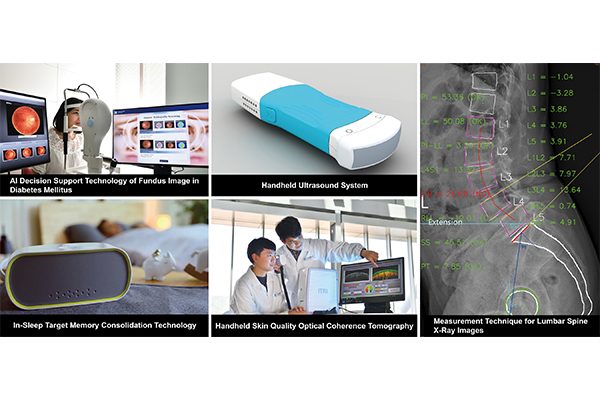-Technologies include In-Sleep Target Memory Consolidation Technology, Handheld Skin Quality Optical Coherence Tomography, Handheld Ultrasound System, Measurement Technique for Lumbar Spine X-Ray Images, and AI Decision Support Technology of Fundus Image in Diabetes Mellitus.

The Industrial Technology Research Institute (ITRI), Taiwan's largest and one of the world's leading high-tech applied research institutions, today announced it will demonstrate e-health monitoring and inspection technologies at its CES 2021 event site (https://event.itri.org/CES2021). ITRI's e-health monitoring and inspection technologies include In-Sleep Target Memory Consolidation Technology that strengthens memory of selected subjects; the Handheld Skin Quality Optical Coherence Tomography system, the first handheld non-invasive OCT system to analyze subsurface skin structures and detect collagen distribution in the dermis layer; the Handheld Ultrasound System for performing ultrasound exams anywhere, anytime; the Measurement Technique for Lumbar Spine X-Ray Images to reduce time and labor for lumbar spine X-ray interpretation; and the AI Decision Support Technology of Fundus Image in Diabetes Mellitus for early detection and timely treatment of diabetic retinopathy (DR).
ITRI's In-Sleep Target Memory Consolidation (ISTMC) Technology offers users a breakthrough capability of seamlessly strengthening the memorization of selective subjects without wearing any sensors such as electroencephalography (EEG) sensors. During the day, a user reads out loud the subjects to be memorized, such as new words and phrases of a foreign language, anatomical details of the human body, provisions of an election law, etc., and ITRI's ISTMC device records them. During the night, ITRI's ISTMC device detects when the user is in the deep sleep stage and replays the recorded sounds to reinforce the brain's process of transferring the sounds' corresponding memorized subjects from short-term memory to long-term memory. The key enabling technology of this innovative device is the ability to detect, reliably and accurately, when a user enters the deep sleep stage based solely on the user's breathing rate, heart rate and body movement, which are measured by the application of recurrent neural network technology to the channel state information (CSI) in the Wi-Fi signals emitted by the user's smartphone.
ITRI developed the Handheld Skin Quality Optical Coherence Tomography system to replace the conventional approach of an invasive biopsy for examining tissue underneath the skin. It is the first handheld optical coherence tomography (OCT) system that analyzes subsurface skin structures and detects collagen distribution in the dermis layer. The technology incorporates a built-in skin quality analysis model, AI, and anti-shake image capturing technology to evaluate skin quality within 10 seconds. It weighs less than 400 grams (14 ounces), allowing users to operate the device with one hand. This innovation is used for medical purposes and provides valid scientific proof for product development in the cosmetic industry, shortening time-to-market while reducing the number of animals used in experiments. The device combines an optomechanical-electronics controller and an image processor to provide 3D optical biopsy using a broadband near-infrared light source. It features high resolution (of few microns), a fast scan rate, and a user-friendly design. It determines skin quality by analyzing key parameters including dermis thickness, epidermis thickness, collagen density, pore size, and the number of blood vessels.
The Handheld Ultrasound System enables healthcare professionals to perform ultrasound exams anywhere, anytime, and it saves critical time in emergency and intensive care. It includes a lightweight, portable scanner and a mobile application. The 64-channel system supports changeable transducers (linear 7.5MHz/convex 3.5MHz) and can process B-mode and color Doppler mode images. In the future, deep learning technology can be integrated to perform quantitative analysis for diagnosis of liver diseases.
The Measurement Technique for Lumbar Spine X-Ray Images combines deep learning and image processing algorithms to reduce time and labor for lumbar spine X-ray interpretation. The system provides real-time measurements of pelvic incidence (PI) and lumbar lordosis (LL), and abnormal findings such as spondylolisthesis. It also can assist in surgical planning and offers precise calculation of surgical implants for clinical diagnosis. The system uses AI to conduct X-ray imaging simulation and enable prediction of postoperative PI and LL values for clinical and auxiliary analysis.
The AI Decision Support Technology of Fundus Image in Diabetes Mellitus is the first AI technology to enable early detection and timely treatment of diabetic retinopathy (DR) by classifying and locating lesions and determining DR severity. It locates the four main DR lesions including microaneurysms, hemorrhages, soft exudates, and hard exudates, and classifies examination results into one of the five stages of DR (no DR; mild, moderate, or severe non-proliferative DR; or proliferative DR). It uses AI to provide binary decision support for ophthalmologist referrals, and optimal treatment timing for Clinical Significant Macular Edema (CSME).
The global news network AVING News has dispatched reporters to CES for 15 consecutive years since 2006, reporting the most number of news globally. After exhibition, it will hold CES 2021 Review Conference to share insight on CES at the end of January.
* MIK (Made in Korea) project in CES 2019-2020 to promote Korean companies to the world
* BEST OF CES since 2015 to select outstanding products by each sector
* The first CES review event CES Review Conference held every year since 2015
→ Go to CES 2021 All Digital special news page
